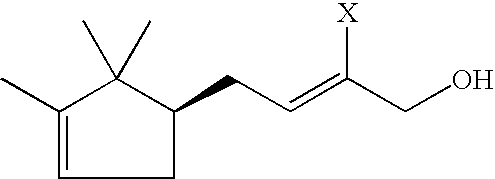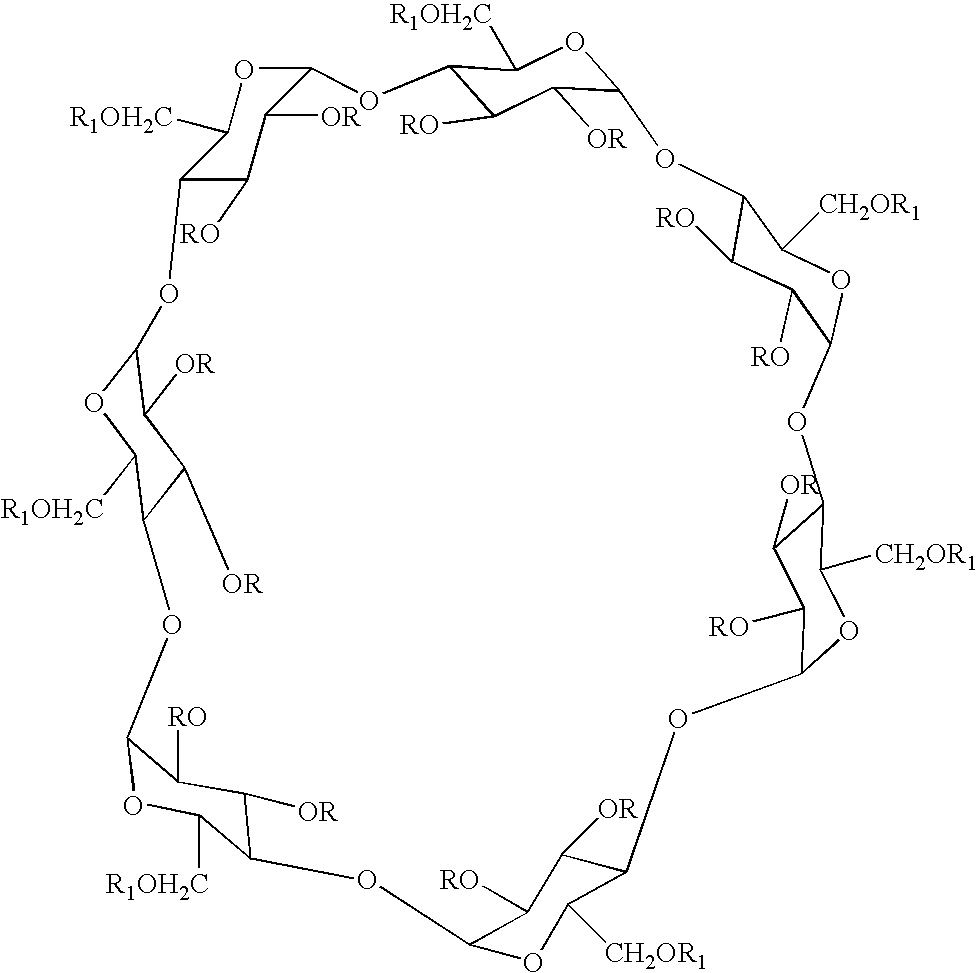Method for determining the enantiomer ratio trimethylcyclopentene derivatives
a trimethylcyclopentane and derivative technology, applied in the field of determining the enantiomer ratio trimethylcyclopentane derivatives, can solve the problems of efforts to separate the enantiomers of 2-methyl-4-, 2-methyl-4-, -ethyl-2,2-dimethylcyclopent-3-en-1-yl)-but-3-enal and 2-methyl-4-
- Summary
- Abstract
- Description
- Claims
- Application Information
AI Technical Summary
Benefits of technology
Problems solved by technology
Method used
Image
Examples
example 1
Determination of the Enantiomer Ratio of Campholene Aldehyde:
The enantioselective capillary gas chromatography of commercially available campholene aldehyde (substance produced by Glidco) was carried out on a Fisons Instruments GC 8000 gas chromatograph, equipped with a split / splitless injector and a flame ionization detector (carrier gas: H2, column head pressure: 95 kPa; injector temperature: 240° C.; split flow: 30 mL / min; detector temperature: 250° C.). Separation was achieved by means of a 30 m×0.23 mm id Duran glass column loaded with a stationary phase of 30 wt. % of heptakis(2,3-di-O-methyl-6-O-tert-butyldimethylsilyl)-β-cyclodextrin and 70 wt. % of SE 52 (film thickness: 0.23 μm). The temperature program was as follows: isothermal for 5 min at 60° C., at a heating rate of 2° C. / min to a final temperature of 210° C., this was maintained for 10 min.
Retention times: (S)-α-campholene aldehyde (26.5 min)
(R)-α-campholene aldehyde (26.9 min)
example 2
Determination of the Enantiomer Ratio of 2-methyl-4-(2,2,3-trimethylcyclopent-3-en-1-yl)-but-2-enal:
The enantioselective capillary gas chromatography of 2-methyl-4-(2,2,3-trimethylcyclopent-3-en-1-yl)-but-2-enal, which was prepared from commercially available campholene aldehyde according to example 1 by condensation with propionaldehyde, was carried out on a Fisons Instruments GC 8000 gas chromatograph, equipped with a split / splitless injector and a flame ionization detector (carrier gas: H2, column head pressure: 95 kPa; injector temperature: 240° C.; split flow: 30 mL / min; detector temperature: 250° C.). Separation was achieved by means of a 30 m×0.23 mm id Duran glass column loaded with a stationary phase of 50 wt. % of heptakis(2,3-di-O-acetyl-6-O-tert-butyldimethylsilyl)-β-cyclodextrin and 50 wt. % of OV 1701-vi (film thickness: 0.23 μm). The temperature program was as follows: isothermal for 5 min at 60° C., at a heating rate of 2° C. / min to a final temperature of 210° C.,...
example 3
Determination of the Enantiomer Ratio of 2-methyl-4-(2,2,3-trimethylcyclopent-3-en-1-yl)-but-2-enol:
The enantioselective capillary gas chromatography of 2-methyl-4-(2,2,3-trimethylcyclopent-3-en-1-yl)-but-2-enol, which was prepared by way of selective reduction of the aldehyde precursor according to example 2, was carried out on a Fisons Instruments GC 8000 gas chromatograph, equipped with a split / splitless injector and a flame ionization detector (carrier gas: H2, column head pressure: 95 kPa; injector temperature: 240° C.; split flow: 30 mL / min; detector temperature: 250° C.). Separation was achieved using a 30 m×0.23 mm id Duran glass column loaded with a stationary phase of 50 wt. % of heptakis(2,3-di-O-acetyl-6-O-tert-butyldimethylsilyl)-β-cyclodextrin and 50 wt. % of OV 1701-vi (film thickness: 0.23 μm).
Temperature program: isothermal at 40° C. for 5 min, at a heating rate of 20° C. / min to 80° C., after a further isothermal step for 200 min, at a heating rate of 0.5° C. / m...
PUM
| Property | Measurement | Unit |
|---|---|---|
| temperature | aaaaa | aaaaa |
| temperature | aaaaa | aaaaa |
| temperature | aaaaa | aaaaa |
Abstract
Description
Claims
Application Information
 Login to View More
Login to View More - R&D
- Intellectual Property
- Life Sciences
- Materials
- Tech Scout
- Unparalleled Data Quality
- Higher Quality Content
- 60% Fewer Hallucinations
Browse by: Latest US Patents, China's latest patents, Technical Efficacy Thesaurus, Application Domain, Technology Topic, Popular Technical Reports.
© 2025 PatSnap. All rights reserved.Legal|Privacy policy|Modern Slavery Act Transparency Statement|Sitemap|About US| Contact US: help@patsnap.com



